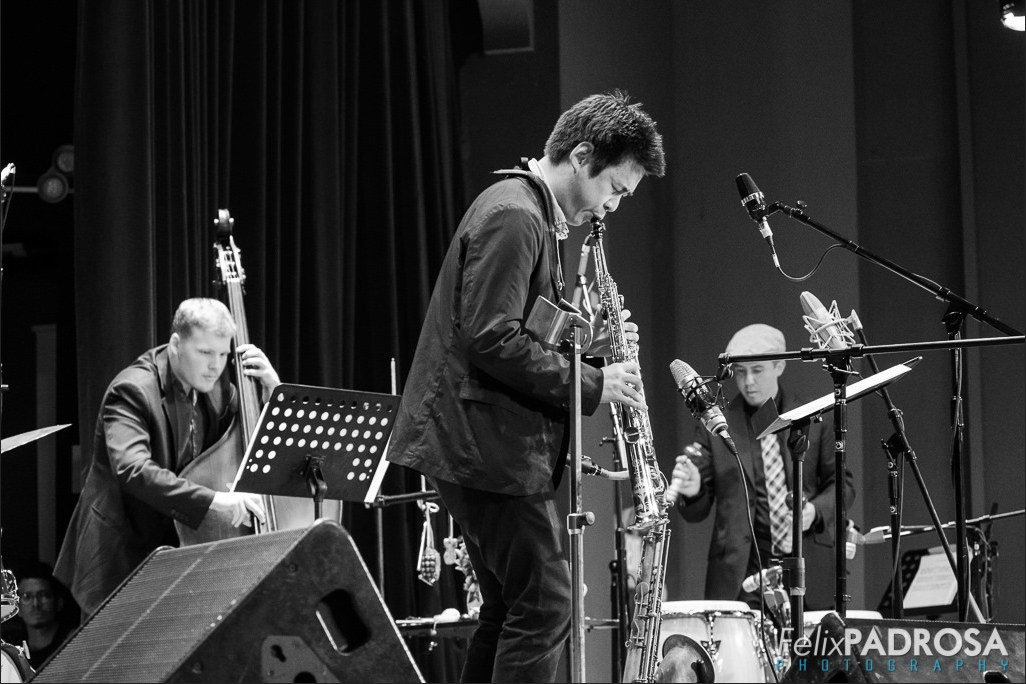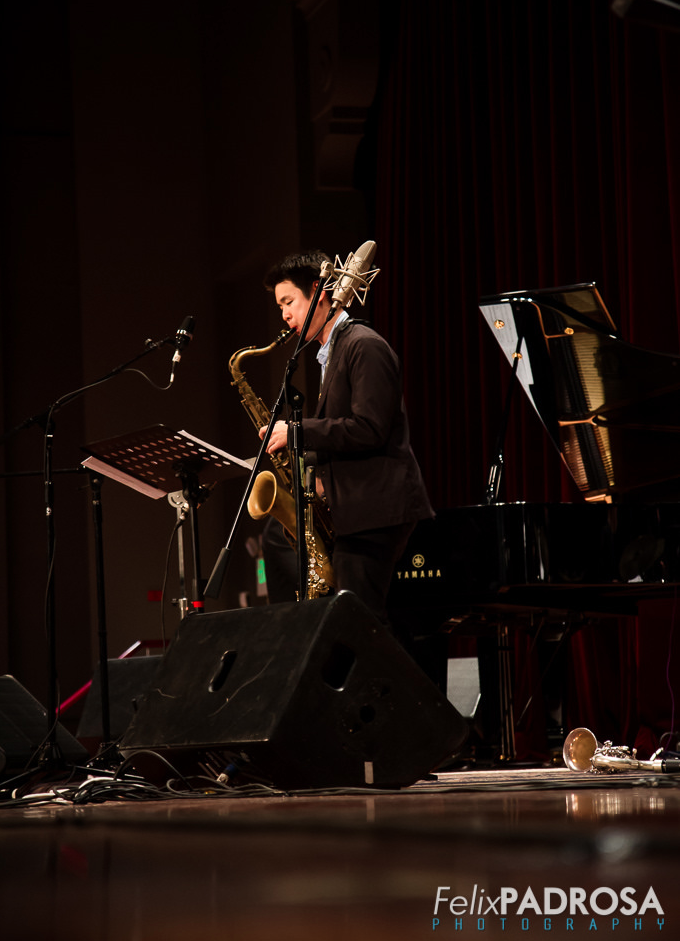I've realized more and more the value of "unpacking" after traveling. Beyond the dirty laundry and travel-sized toiletries and the perpetually tiresome Facebook-iPhoto interface, it's like a tranche of gum after a nice meal to try to tabulate and assess what really happened, or, rather, what I think about what happened.
First, some obligatory gig photos:
 |
| Night one: opening for Brian Blade Fellowship |
 |
| Post-opening with the compadres (l-r): Isaac Wilson, Kevin Sun, Mike Dick, Fran Vielma, Dan Raney |
 |
| Working on my bass clarinet posture, thinking Dolphy |
 |
| Band photo-op with maestro Rubén Blades |
 |
Sound checking at Danilo's
|
 |
| Saturday on the big stage, a dedicated crowd out in the rain |
 |
| Another view of the same, now with purple light |
The purpose of the trip was ostensibly education, to spread this American music to strengthen communities in Panamá and give opportunities to students who didn't have many to begin with. The Times did a nice featurette (look for my green-shirted "Where's Waldo?" cameo in one of the photographs) on Danilo Pérez's work in Panama, which is also the work of his wife, saxophonist Patricia Zarate, who deals with most of the logistical components of the Panama Jazz Festival, and the army of volunteers who exercised both extreme fortitude in seeing through the innumerable things to be done day to day, hour to hour, minute to minute, and extreme patience in giving clueless folk like me directions in a foreign country. Some context from the piece:
Nearly 30 years after he left his native Panama to study
jazz composition at Berklee, he has made promoting musicianship in Panama —
using music as a springboard, cultural unifier and teaching tool — his life’s
work. In 2005, a year after he started the jazz festival with his family, he
created the Danilo Pérez Foundation, a nonprofit center for music education and
outreach; the festival, which draws as many as 30,000 people over its six-day
run each January, provides money for the foundation....
...Run on a tight budget, the foundation took donations of
instruments from colleagues like Mr. Patitucci and the Cuban pianist Chucho
Valdés. Similarly, the festival is staffed by hundreds of volunteers, said
Patricia Zarate, its executive director, a saxophonist and Mr. Pérez’s wife. A
festival of this scope would likely cost $1 million to $3 million to produce,
she said, “and we do it with less than $500,000.” The musicians are paid on a
sliding scale, and backing comes from the Panamian government and sponsors like
Copa Airlines.
The opening scene of the story is at one of the jam sessions
at Danilo's Jazz Club in the old district of Panama City:
And here he was, at 1:30 a.m. Friday, sitting behind the
grand piano in the intimate Danilo’s Jazz Club, the city’s only performance
space dedicated exclusively to jazz, now packed with friends and visitors. He
was joined by John Patitucci, the Shorter quartet bassist, and a host of
international musicians and students, eager to improvise alongside the masters.
Nêgah Santos, 24, a Brazilian powerhouse in denim shorts, gave her congas a
workout; Samuel Batista, 24, a Panamanian in his third year at the Berklee
College of Music in Boston, drew full-throated cheers with his saxophone. The
jam lasted until closing time, and afterward Mr. Pérez gathered his young
charges at a cocktail table to dispense encouragement and wisdom. “This kind of
thing wakes you up, right?” he said, grinning.
That night, I had played "Inner Urge" on soprano
after electing not to bring the tenor for the sake of convenience; right after,
Danilo and John Patitucci took the stage and started rolling out on
"Evidence" (Danilo also played "Four in One" over the
"Evidence" hits, alluding to his arrangement from nearly two decades
ago on PanaMonk, of which a framed print of the cover hangs on a wall in the
club). I got offstage immediately, ceding to the elders, but after hearing my
friend Edmar Colón bring down the house with a long, roaring solo, I decided I
couldn't pass up the chance to play.
On an afternoon a few days before, my bandmates and I had arrived at the club to soundcheck for our sets that night and ran into another Panamanian Renaissance man, Rubén Blades, finishing up a rehearsal with Danilo, John, and Brian Blade for their show at the PJF gala that evening. He indulged us with a few stories of working with Danilo, including once performing a duet where the introduction, a winding maze of the pianist's making, led Blades to the void, where he closed his eyes and dived in, having no other recourse. He said that after the performance, he was walking home with his wife, a professionally trained musician, who asked, "How did you sing that?" He said he had no memory—it was a performance-induced lacuna, selective amnesia.
When I stepped onstage and started playing, I glanced toward the piano (I usually play with my eyes closed) and was immediately cast into Danilo's orbit, the way he looked at me as he was comping. Of course, I also immediately lost the form and the thought entered my mind: "This must be what Wayne feels like when he plays" (save for the fear and shock that came over me in the moment).
A few nights after, I had a chance to ask Danilo how he conceptualized playing with such freedom, and he starting drawing concentric circles with his fingers along the head of a conga drum in front of him. "We play around the form, you know what I mean?" The circles became ellipses and stretched and compressed, occasionally colliding with one another, generating ricochets that emerged with their own new orbits.
I myself also had the chance to teach a bit: I gave an hour-long clinic on the basics of transcribing as I understood them, as well as a couple of gratis private lessons. With a classroom full of saxophonists of widely varying levels of experience, we were able to learn eight bars of Lester Young's "Pound Cake" solo (transcription below). I made a little handout, one in English and one in Spanish with the help of a good friend, linguist, and bassist, Andrés Enrique-Arias.
 |
| No phrase/articulation markings |
 |
| Marked up |
"Pound Cake": C, Bb, Eb
"TRANSCRIBING" (English), PDF here:
"TRANSCRIBIR" (espanol), PDF aquí:
It was a real pleasure to contribute the small amount that I could for a few days in Panama. I'm grateful to Danilo, Patricia, and the extraordinary volunteers for putting this together, as well as the Danilo Perez Foundation; my bandmates, Isaac Wilson, Mike Dick, Dan Raney, and Francisco Vielma for pushing through the countless hours of rehearsal it took to get the music together in the months before; Ken Schaphorst, the NEC Jazz Department's fearless leader and advocate of education and the beach; Nathan Scalise, our fearless host and resident NEC-Panama Jazz Festival intern; everybody at Berklee Global Jazz for the hang and bridging the gap between passing ships; and the students for inspiration and encouragement. Onward!
* * * * *
Postscript, 1.21.15
Photographer Felix Padrosa took some fine photographs from our first concert in Panama last Monday. For those who don't know, I've long been overmatched on Google Image search by an infinitely more photogenic, tanned, muscular, and all-around model-esque fellow who shares my name—thus, I'm reposting (with the permission of Felix) some of his photos to help direct curious Internet-goers who might mistake him for myself. Take a look at the full set on in Felix's flickr album here.
 |
| Photo: Felix Padrosa |
 |
| Photo: Felix Padrosa |
 |
| Photo: Felix Padrosa |
 |
| Photo: Felix Padrosa |
 |
| Caption contest? (Photo: Felix Padrosa) |
Video of our entire second set at Danilo's Jazz Club last Tuesday is also available here, courtesy of WWOZ New Orleans 90.7 FM, which live-streamed every night of the week at the club during the Panama Jazz Festival.



















Comments
Post a Comment